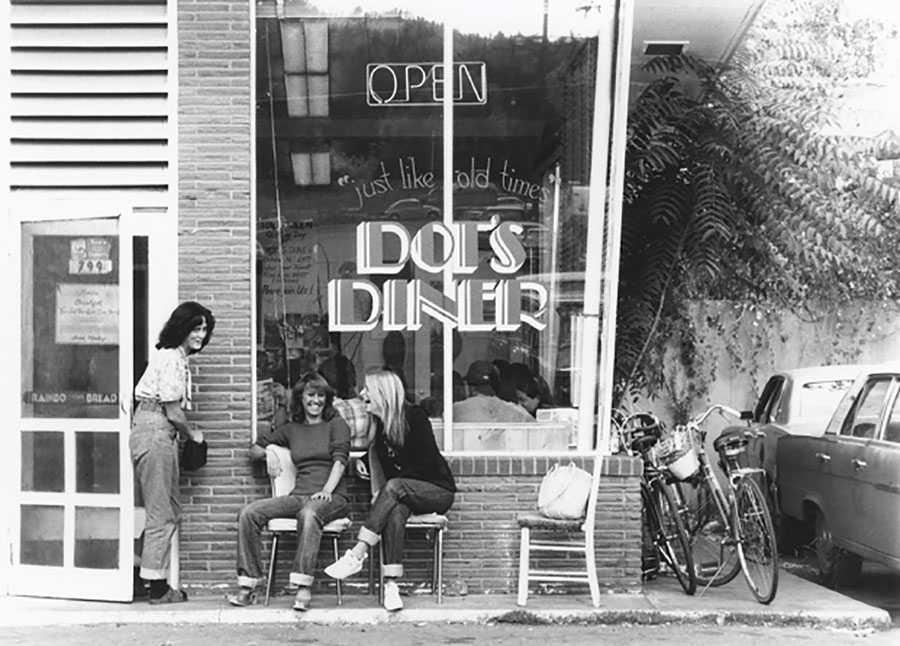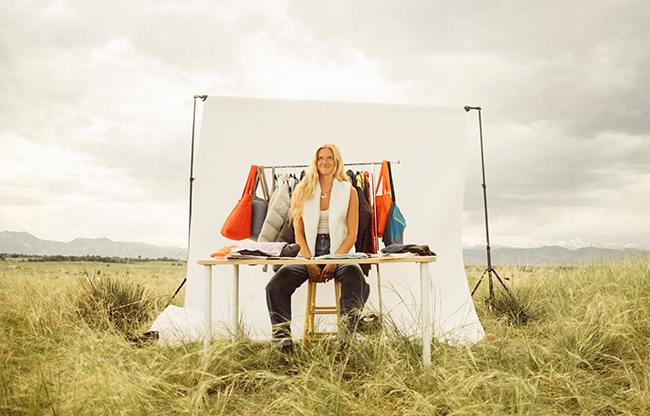Colorado’s New Gold Rush
01 Dec 2013
Colorado's New Gold Rush
By Kay TurnbaughThe marijuana industry and pot-friendly towns pick their way toward the motherlode
The nation’s opinion about marijuana is starting to catch up with Colorado’s. In late October, a Gallup poll found that for the first time, a majority of Americans—58 percent—thought marijuana should be legal.
Last year, Colorado voters made recreational pot legal when they approved Amendment 64 to the state constitution. On May 28, 2013, Colorado Gov. John Hickenlooper signed two bills defining the state’s regulated recreational cannabis market for adults.
By all predictions, it’s going to be a pretty big industry. The Colorado Center on Law & Policy estimates that Colorado could see $60 million in total combined savings and additional revenue to the state’s budget, “with a potential for this number to double after 2017.” The Marijuana Policy Project estimated that the nation’s marijuana industry was worth $1.7 billion in 2011, with the potential to grow to $8.9 billion by 2016. That would be a 523-percent growth rate in five years.
As mind-boggling as these figures are, it’s the potential tax revenue that has politicians salivating. Colorado could pull in $27.5 million in 2014 from the 15-percent excise tax (which is levied on the wholesale price of pot when it is transferred from the grow room to the showroom) and the 10 percent sales tax voters overwhelmingly approved in November. That’s on top of the state’s current 2.9-percent sales tax, which could raise $17.6 million, and any additional local sales tax on purchases of recreational pot.
In addition to the new state taxes, voters agreed to add local taxes on retail marijuana sales in Fraser, Red Cliff, Carbondale, Littleton, Boulder and Denver by a margin of 2-1. Only in Pueblo County was a local tax election issue even remotely close, and there 60 percent of voters agreed to a 3.5-percent tax.
What will this mean at the checkout counter? A customer buying an eighth-ounce of marijuana for $30 in a new retail pot shop in Denver will pay an estimated $8.59 in tax ($6 in state taxes and $2.59 in local taxes), or about 29 percent. In Boulder the tax will probably be a bit higher, a little over 30 percent.

4:20, scenic beauty or both?As lucrative as the pot industry sounds, it’s still a far cry from tourism, one of Colorado’s biggest industries, worth roughly $17 billion last year. How will the two industries, pot and tourism, interact? Will legal pot shops draw more tourists to Colorado? Or will tourists stay away because marijuana is legal?It looks like they’ll have a choice. Places like Colorado Springs may get to be known as “safe” from marijuana. Others, like Breckenridge and Telluride, will welcome tourists who are seeking marijuana as part of their Colorado experience. Tours are already being offered by companies like Denver’s My 420 Tours, whose $1,000, four-day Mountain Tour includes a daily 4:20 Happy Hour party, snacks and meals, a cannabis cooking and recipe class, a medical-marijuana dispensary and grow tour, a concert, transportation, and discounts at restaurants and the Denver Art Museum.
Al White, director of the Colorado Tourism Office, says it’s not something his office is going to market. He believes that the state’s scenic beauty and recreational opportunities are still the prime draws for visitors. “Whether it’s good for the brand of our state is still up in the air,” Gov. Hickenlooper has said.
Nederland, the small mountain town just west of Boulder whose economy is based in large part on tourism, decided to embrace the legalization of pot and the chance to have some legal pot shops in town. At the same time, Mayor Joe Gierlach said, the town didn’t want the “seamy” reputation that has followed Amsterdam over the years. “Tourism,” he says, “isn’t necessarily our goal.”
The state has issued its own lengthy regulations, but Amendment 64 allows local jurisdictions to decide whether to allow retail sales. Location, signage, advertising—all aspects beyond the product itself—are up to local governments. The state’s cities and counties that wanted to take more time to prepare for legal pot shops were required by Amendment 64 to institute a moratorium by Oct. 1, 2013. Many of them will end up allowing retail marijuana establishments in six months or a year. Others decided to ban the sale of marijuana outright.
Walking the tightrope in Boulder
Deciding how to implement Amendment 64 locally is a fascinating process to watch, but often frustrating for those involved. Shawn Coleman, a lobbyist for the marijuana industry, says successful implementation of the law was predicated on existing medical-marijuana businesses’ converting first, leading the way. But even the conversion process is messy at the local level. Staffs often feel overwhelmed, and politicians are caught in the hot spot between community members with varying opinions about marijuana and businesses that already bring enormous tax revenue into their communities and are likely to bring more.
The Boulder City Council held several contentious meetings about its proposed regulations, and eventually eased some of the stricter regulations proposed by staff in response to business concerns. The council recognized the huge investment existing medical-marijuana businesses have made, and used their input, alongside the community’s, to guide their decisions.
Currently, Boulder has 39 pending applications for marijuana businesses, 13 of which are for new medical-marijuana licenses. The city already has 25 existing medical centers. It will start accepting applications from medical-marijuana businesses that want to convert to retail on Jan. 2. Those existing businesses have until March 1 to apply for a retail license.
Staff had proposed limits on the number of plants growers could raise, but after hearing from business owners, the council agreed there would be no limit on the number of plants. Growers will be required to pay $1 for each plant over 1,000.
Other regulations the council has agreed to include limiting a single store owner to working with no more than five grow operations. Cultivation facilities are already limited to 15,000 square feet by zoning regulations. The council also reduced the penalties for odor violations, the most common complaint the city receives about growers. With the new rules, businesses will get an opportunity to take care of the problem before they are issued a ticket or their license is revoked.
Boulder asked voters to approve a 5-percent excise tax on marijuana that was increased to as much as 10 percent in the November election. Voters agreed. Some of the money raised through the tax will be spent on drug-education and treatment programs.
In the election, Colorado voters also passed a state proposal to impose a 15-percent excise tax and a 10-percent state sales tax on top of the existing 2.9-percent state sales tax. The first $40 million in collected revenue on sales that start on Jan. 1 will go to school construction. After that, 15 percent of the revenue will be distributed to counties that approved retail sales. In late October, Colorado Counties Inc., a lobbying group, asked the state legislature to consider also distributing that 15 percent to counties that don’t permit marijuana sales.
 Nederland mayor Joe Gierlach outside one of the town's
three medical-marijuana centers.
‘Cottage industry’ in Ned
When Amendment 64 passed, those in the marijuana industry knew that there would be taxes imposed to help pay for regulation of the industry. However, many thought that Boulder’s ballot issue ushered in an unnecessary “cash grab” that almost doubled the state taxes. There’s a “tipping point” where, if taxes get too high, people may return to under-the-table sales, something Amendment 64 aimed to stop.
In contrast to Boulder, Nederland decided against levying a local tax on retail marijuana businesses. Instead, Nederland’s goal is to legitimize an underground industry and make it easy to convert to regulated status.
“If we take our local industry and legitimize it, the bump we’ll get in our sales tax will be sizable. We don’t want to put an additional burden on this industry,” Gierlach says.
He explains the back story: “When medical marijuana was legalized a couple of years ago, we had seven start-ups, but only three of them have lasted.” The town realized that the cost of completing the paperwork and paying taxes was difficult. In the meantime, Nederland had become home to two businesses that sell equipment and supplies, like grow lights, hydroponic equipment and fertilizer. Those two businesses generate $1.2 million in sales every year, and the sales tax they generate has been good for the small town’s budget. It became apparent to the town that bringing marijuana-related enterprises into compliance could be an economic boon.
There are public-safety and environmental issues as well. A mayor’s task force began looking at the problems of unregulated marijuana growing. There were reports that powerful fertilizers were being flushed into the town’s sewer system. Growers would sell the best part of their plants—the buds—and discard the rest outside, causing dogs and possibly wildlife to get intoxicated from eating the discarded plants. Growing marijuana also requires an intense amount of electricity. Grow lights can use 1,500 watts apiece, and they need to be on for as much as 18 hours at a time. Putting even two grow lights on a typical residential circuit creates a potential fire danger.
“The goal of the task force was to make it easy and convenient to get the inspections, the proper wiring, to dispose of waste correctly, to have the proper filters for air and drains,” says Gierlach. “There’s a right way to do it and a wrong way to do it. We decided to treat it as a cottage industry.”
The next step was to figure out how that cottage industry could sell its product legally. Amendment 64 provided the framework, and Nederland went to work on the details, the mayor says. “We worked on our code for eight months. It was rigorously debated, and we got input from the Colorado Municipal League and attorneys. We feel what we’ve come up with is a pretty good balance.
“It’s going to be a slow transition,” says Gierlach. “We may have only one shop for the first year. After that, there may be more. I don’t think we’ll see the full impact of Amendment 64 until two years from now.”
Nederland mayor Joe Gierlach outside one of the town's
three medical-marijuana centers.
‘Cottage industry’ in Ned
When Amendment 64 passed, those in the marijuana industry knew that there would be taxes imposed to help pay for regulation of the industry. However, many thought that Boulder’s ballot issue ushered in an unnecessary “cash grab” that almost doubled the state taxes. There’s a “tipping point” where, if taxes get too high, people may return to under-the-table sales, something Amendment 64 aimed to stop.
In contrast to Boulder, Nederland decided against levying a local tax on retail marijuana businesses. Instead, Nederland’s goal is to legitimize an underground industry and make it easy to convert to regulated status.
“If we take our local industry and legitimize it, the bump we’ll get in our sales tax will be sizable. We don’t want to put an additional burden on this industry,” Gierlach says.
He explains the back story: “When medical marijuana was legalized a couple of years ago, we had seven start-ups, but only three of them have lasted.” The town realized that the cost of completing the paperwork and paying taxes was difficult. In the meantime, Nederland had become home to two businesses that sell equipment and supplies, like grow lights, hydroponic equipment and fertilizer. Those two businesses generate $1.2 million in sales every year, and the sales tax they generate has been good for the small town’s budget. It became apparent to the town that bringing marijuana-related enterprises into compliance could be an economic boon.
There are public-safety and environmental issues as well. A mayor’s task force began looking at the problems of unregulated marijuana growing. There were reports that powerful fertilizers were being flushed into the town’s sewer system. Growers would sell the best part of their plants—the buds—and discard the rest outside, causing dogs and possibly wildlife to get intoxicated from eating the discarded plants. Growing marijuana also requires an intense amount of electricity. Grow lights can use 1,500 watts apiece, and they need to be on for as much as 18 hours at a time. Putting even two grow lights on a typical residential circuit creates a potential fire danger.
“The goal of the task force was to make it easy and convenient to get the inspections, the proper wiring, to dispose of waste correctly, to have the proper filters for air and drains,” says Gierlach. “There’s a right way to do it and a wrong way to do it. We decided to treat it as a cottage industry.”
The next step was to figure out how that cottage industry could sell its product legally. Amendment 64 provided the framework, and Nederland went to work on the details, the mayor says. “We worked on our code for eight months. It was rigorously debated, and we got input from the Colorado Municipal League and attorneys. We feel what we’ve come up with is a pretty good balance.
“It’s going to be a slow transition,” says Gierlach. “We may have only one shop for the first year. After that, there may be more. I don’t think we’ll see the full impact of Amendment 64 until two years from now.”
Nederland resident Kay Turnbaugh writes about a variety of subjects for Boulder Magazine. She is the author of Around Nederland, the award-winning The Last of the Wild West Cowgirls, and The Mountain Pine Beetle—Tiny but Mighty.
 Nederland mayor Joe Gierlach outside one of the town's
three medical-marijuana centers.
‘Cottage industry’ in Ned
When Amendment 64 passed, those in the marijuana industry knew that there would be taxes imposed to help pay for regulation of the industry. However, many thought that Boulder’s ballot issue ushered in an unnecessary “cash grab” that almost doubled the state taxes. There’s a “tipping point” where, if taxes get too high, people may return to under-the-table sales, something Amendment 64 aimed to stop.
In contrast to Boulder, Nederland decided against levying a local tax on retail marijuana businesses. Instead, Nederland’s goal is to legitimize an underground industry and make it easy to convert to regulated status.
“If we take our local industry and legitimize it, the bump we’ll get in our sales tax will be sizable. We don’t want to put an additional burden on this industry,” Gierlach says.
He explains the back story: “When medical marijuana was legalized a couple of years ago, we had seven start-ups, but only three of them have lasted.” The town realized that the cost of completing the paperwork and paying taxes was difficult. In the meantime, Nederland had become home to two businesses that sell equipment and supplies, like grow lights, hydroponic equipment and fertilizer. Those two businesses generate $1.2 million in sales every year, and the sales tax they generate has been good for the small town’s budget. It became apparent to the town that bringing marijuana-related enterprises into compliance could be an economic boon.
There are public-safety and environmental issues as well. A mayor’s task force began looking at the problems of unregulated marijuana growing. There were reports that powerful fertilizers were being flushed into the town’s sewer system. Growers would sell the best part of their plants—the buds—and discard the rest outside, causing dogs and possibly wildlife to get intoxicated from eating the discarded plants. Growing marijuana also requires an intense amount of electricity. Grow lights can use 1,500 watts apiece, and they need to be on for as much as 18 hours at a time. Putting even two grow lights on a typical residential circuit creates a potential fire danger.
“The goal of the task force was to make it easy and convenient to get the inspections, the proper wiring, to dispose of waste correctly, to have the proper filters for air and drains,” says Gierlach. “There’s a right way to do it and a wrong way to do it. We decided to treat it as a cottage industry.”
The next step was to figure out how that cottage industry could sell its product legally. Amendment 64 provided the framework, and Nederland went to work on the details, the mayor says. “We worked on our code for eight months. It was rigorously debated, and we got input from the Colorado Municipal League and attorneys. We feel what we’ve come up with is a pretty good balance.
“It’s going to be a slow transition,” says Gierlach. “We may have only one shop for the first year. After that, there may be more. I don’t think we’ll see the full impact of Amendment 64 until two years from now.”
Nederland mayor Joe Gierlach outside one of the town's
three medical-marijuana centers.
‘Cottage industry’ in Ned
When Amendment 64 passed, those in the marijuana industry knew that there would be taxes imposed to help pay for regulation of the industry. However, many thought that Boulder’s ballot issue ushered in an unnecessary “cash grab” that almost doubled the state taxes. There’s a “tipping point” where, if taxes get too high, people may return to under-the-table sales, something Amendment 64 aimed to stop.
In contrast to Boulder, Nederland decided against levying a local tax on retail marijuana businesses. Instead, Nederland’s goal is to legitimize an underground industry and make it easy to convert to regulated status.
“If we take our local industry and legitimize it, the bump we’ll get in our sales tax will be sizable. We don’t want to put an additional burden on this industry,” Gierlach says.
He explains the back story: “When medical marijuana was legalized a couple of years ago, we had seven start-ups, but only three of them have lasted.” The town realized that the cost of completing the paperwork and paying taxes was difficult. In the meantime, Nederland had become home to two businesses that sell equipment and supplies, like grow lights, hydroponic equipment and fertilizer. Those two businesses generate $1.2 million in sales every year, and the sales tax they generate has been good for the small town’s budget. It became apparent to the town that bringing marijuana-related enterprises into compliance could be an economic boon.
There are public-safety and environmental issues as well. A mayor’s task force began looking at the problems of unregulated marijuana growing. There were reports that powerful fertilizers were being flushed into the town’s sewer system. Growers would sell the best part of their plants—the buds—and discard the rest outside, causing dogs and possibly wildlife to get intoxicated from eating the discarded plants. Growing marijuana also requires an intense amount of electricity. Grow lights can use 1,500 watts apiece, and they need to be on for as much as 18 hours at a time. Putting even two grow lights on a typical residential circuit creates a potential fire danger.
“The goal of the task force was to make it easy and convenient to get the inspections, the proper wiring, to dispose of waste correctly, to have the proper filters for air and drains,” says Gierlach. “There’s a right way to do it and a wrong way to do it. We decided to treat it as a cottage industry.”
The next step was to figure out how that cottage industry could sell its product legally. Amendment 64 provided the framework, and Nederland went to work on the details, the mayor says. “We worked on our code for eight months. It was rigorously debated, and we got input from the Colorado Municipal League and attorneys. We feel what we’ve come up with is a pretty good balance.
“It’s going to be a slow transition,” says Gierlach. “We may have only one shop for the first year. After that, there may be more. I don’t think we’ll see the full impact of Amendment 64 until two years from now.”
Nederland resident Kay Turnbaugh writes about a variety of subjects for Boulder Magazine. She is the author of Around Nederland, the award-winning The Last of the Wild West Cowgirls, and The Mountain Pine Beetle—Tiny but Mighty.
MEDICAL VS. RECREATIONAL MARIJUANA
Only existing medical marijuana businesses are eligible to apply for recreational licenses before Jan. 1, and that’s only in areas where there is no moratorium or ban.MEDICAL MARIJUANA
RECREATIONAL MARIJUANA
HIGH TIMES ON THE SLOPES
Who will make the most money? It may not be the people who grow and sell the pot. Auxiliary-services firms that handle security, financial data, advertising and product research are poised to make a fortune. Private-equity funds are looking forward to buying up smaller marijuana-related businesses and creating big, fat ones, and investors are rushing to find consulting firms, software companies and insurance agencies to serve the new market. RULES & REGULATIONS Boulder County In the unincorporated areas of Boulder County, existing medical-marijuana facilities can seek a county license to grow, manufacture, test, store and sell marijuana and marijuana products for recreational use. The county begins accepting applications on Dec. 9. Anyone who wants to open a new recreational-marijuana business must wait until at least Jan. 1, 2015, to apply for a license. County regulations include provisions to prevent or discourage youths’ purchase of marijuana. Shops will have an electronic ID scanner to help prevent anyone under 21 from being inside. Recreational-marijuana receipts will carry a notice that it is illegal to transfer or sell marijuana to anyone under 21. City of Boulder Existing medical-marijuana dispensaries have the option to run recreational and medical-marijuana businesses under the same roof, but in 2014 new businesses will have to choose between medical and recreational. Nearly all the existing medical-marijuana businesses in the city will be able to convert to retail, if that’s what they prefer, in their current locations. The city will allow the existing businesses that decide to cater to both medical and recreational-marijuana buyers to “co-locate” in the same building with separate entrances and a shared lobby where IDs will be checked. Recreational-only marijuana businesses are expected to start opening in January or February 2014. New recreational-marijuana shops cannot be within 1,000 feet of schools, daycare centers, or drug and alcohol rehab centers. Grow operations and infused-product manufacturers cannot be within 500 feet. Other Boulder County cities LAFAYETTE, which has several existing medical-marijuana centers, extended its original moratorium on recreational marijuana, which ended Oct. 1, to April 2014. Starting in 2014, the city will begin drafting a proposal for regulations for recreational-marijuana shops. LONGMONT has adopted an ordinance banning both medical and recreational shops. LOUISVILLE has instituted a moratorium until the end of 2014. The city will put a question on the November 2014 ballot, asking if residents want to have recreational pot shops in the city. In the meantime, the city council will consider allowing the current two medical-marijuana centers to convert to retail. LYONS, which has three MMJ centers, has put a moratorium on recreational-marijuana stores. The town does not plan to revisit the issue until November 2014.
Growing Regulations Medical-marijuana growing operations can be as small as 200 square feet, or as large as 150,000-plus square feet. Cultivation facilities must be licensed and pay fees ranging from $2,750 to $14,000 a year. The more you pay, the more plants you can grow. Denver is the most friendly city in Colorado for growers. The city has no limit on the size of the space, and it’s easier to find industrially zoned space that is the required 500 feet from residential. Boulder caps the square footage of marijuana-cultivation facilities and requires that they either install solar panels or pay the extra to Xcel Energy for renewable energy. It can be tricky to find a landlord who treats marijuana facilities fairly. Horror stories abound about landlords’ raising rents to unreasonable levels after the first two- or three-year lease expires. Most growers can’t afford to move after they have spent the money to bring the space up to code and to satisfy all regulations. Security cameras must be installed over every doorway and trained on the safe, which also must meet fire and safecracker standards. In a typical 5,000-square-foot space, that’s 28 cameras, and the DVR footage from them must be stored for 30 days. The investment can be enormous. Starting a 5,000-square-foot cultivation business will require a minimum of $500,000 over the first three years. “It can be discouraging,” says one local grower. “But if you’re doing something you love, and you like going to work every morning, it’s worth it.” He feels as if he’s working at ground zero, because Colorado is setting the precedents for the country. “What happens everywhere else will be modeled on Colorado.”
- Requires a doctor’s recommendation and a card to enter a dispensary or center.
- Medical marijuana can be sold to patients 18 and older who have a doctor’s recommendation.
- Patients can possess up to 2 ounces of marijuana at a time.
- Regular sales tax applies.
RECREATIONAL MARIJUANA
- Can be sold to customers 21 and older starting Jan. 1, 2014.
- Sales are limited to 1 ounce for state residents and 0.25 ounces for out-of-state visitors.
- Will be taxed at a higher rate than medical marijuana.
- It is still illegal to smoke marijuana in a public place.
HIGH TIMES ON THE SLOPES
- In Colorado, 22 ski areas lease federal land, so using marijuana there can potentially result in fines, revoked passes, or even jail time.
Who will make the most money? It may not be the people who grow and sell the pot. Auxiliary-services firms that handle security, financial data, advertising and product research are poised to make a fortune. Private-equity funds are looking forward to buying up smaller marijuana-related businesses and creating big, fat ones, and investors are rushing to find consulting firms, software companies and insurance agencies to serve the new market. RULES & REGULATIONS Boulder County In the unincorporated areas of Boulder County, existing medical-marijuana facilities can seek a county license to grow, manufacture, test, store and sell marijuana and marijuana products for recreational use. The county begins accepting applications on Dec. 9. Anyone who wants to open a new recreational-marijuana business must wait until at least Jan. 1, 2015, to apply for a license. County regulations include provisions to prevent or discourage youths’ purchase of marijuana. Shops will have an electronic ID scanner to help prevent anyone under 21 from being inside. Recreational-marijuana receipts will carry a notice that it is illegal to transfer or sell marijuana to anyone under 21. City of Boulder Existing medical-marijuana dispensaries have the option to run recreational and medical-marijuana businesses under the same roof, but in 2014 new businesses will have to choose between medical and recreational. Nearly all the existing medical-marijuana businesses in the city will be able to convert to retail, if that’s what they prefer, in their current locations. The city will allow the existing businesses that decide to cater to both medical and recreational-marijuana buyers to “co-locate” in the same building with separate entrances and a shared lobby where IDs will be checked. Recreational-only marijuana businesses are expected to start opening in January or February 2014. New recreational-marijuana shops cannot be within 1,000 feet of schools, daycare centers, or drug and alcohol rehab centers. Grow operations and infused-product manufacturers cannot be within 500 feet. Other Boulder County cities LAFAYETTE, which has several existing medical-marijuana centers, extended its original moratorium on recreational marijuana, which ended Oct. 1, to April 2014. Starting in 2014, the city will begin drafting a proposal for regulations for recreational-marijuana shops. LONGMONT has adopted an ordinance banning both medical and recreational shops. LOUISVILLE has instituted a moratorium until the end of 2014. The city will put a question on the November 2014 ballot, asking if residents want to have recreational pot shops in the city. In the meantime, the city council will consider allowing the current two medical-marijuana centers to convert to retail. LYONS, which has three MMJ centers, has put a moratorium on recreational-marijuana stores. The town does not plan to revisit the issue until November 2014.
Growing Regulations Medical-marijuana growing operations can be as small as 200 square feet, or as large as 150,000-plus square feet. Cultivation facilities must be licensed and pay fees ranging from $2,750 to $14,000 a year. The more you pay, the more plants you can grow. Denver is the most friendly city in Colorado for growers. The city has no limit on the size of the space, and it’s easier to find industrially zoned space that is the required 500 feet from residential. Boulder caps the square footage of marijuana-cultivation facilities and requires that they either install solar panels or pay the extra to Xcel Energy for renewable energy. It can be tricky to find a landlord who treats marijuana facilities fairly. Horror stories abound about landlords’ raising rents to unreasonable levels after the first two- or three-year lease expires. Most growers can’t afford to move after they have spent the money to bring the space up to code and to satisfy all regulations. Security cameras must be installed over every doorway and trained on the safe, which also must meet fire and safecracker standards. In a typical 5,000-square-foot space, that’s 28 cameras, and the DVR footage from them must be stored for 30 days. The investment can be enormous. Starting a 5,000-square-foot cultivation business will require a minimum of $500,000 over the first three years. “It can be discouraging,” says one local grower. “But if you’re doing something you love, and you like going to work every morning, it’s worth it.” He feels as if he’s working at ground zero, because Colorado is setting the precedents for the country. “What happens everywhere else will be modeled on Colorado.”
[divider]
Editor’s note: The Nederland section of this article reflects several corrections of the print version that was published Dec. 1, 2013.
—M.J.












